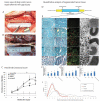Mesenchymal Stem Cells in Nerve Tissue Engineering: Bridging Nerve Gap Injuries in Large Animals
- PMID: 37175506
- PMCID: PMC10177884
- DOI: 10.3390/ijms24097800
Mesenchymal Stem Cells in Nerve Tissue Engineering: Bridging Nerve Gap Injuries in Large Animals
Abstract
Cell-therapy-based nerve repair strategies hold great promise. In the field, there is an extensive amount of evidence for better regenerative outcomes when using tissue-engineered nerve grafts for bridging severe gap injuries. Although a massive number of studies have been performed using rodents, only a limited number involving nerve injury models of large animals were reported. Nerve injury models mirroring the human nerve size and injury complexity are crucial to direct the further clinical development of advanced therapeutic interventions. Thus, there is a great need for the advancement of research using large animals, which will closely reflect human nerve repair outcomes. Within this context, this review highlights various stem cell-based nerve repair strategies involving large animal models such as pigs, rabbits, dogs, and monkeys, with an emphasis on the limitations and strengths of therapeutic strategy and outcome measurements. Finally, future directions in the field of nerve repair are discussed. Thus, the present review provides valuable knowledge, as well as the current state of information and insights into nerve repair strategies using cell therapies in large animals.
Keywords: Schwann cells; cell therapy; growth factors; large animal models; nerve guidance conduit; nerve injury; nerve regeneration; stem cells.
Conflict of interest statement
The authors declare that the research was conducted in the absence of any commercial or financial relationships that could be construed as a potential conflict of interest.
Figures






References
-
- Bain J.R., Mackinnon S.E., Hudson A.R., Wade J., Evans P., Makino A., Hunter D. The peripheral nerve allograft in the primate immunosuppressed with Cyclosporin A: I. Histologic and electrophysiologic assessment. Plast. Reconstr. Surg. 1992;90:1036–1046. doi: 10.1097/00006534-199212000-00015. - DOI - PubMed
-
- Ding F., Wu J., Yang Y., Hu W., Zhu Q., Tang X., Liu J., Gu X. Use of tissue-engineered nerve grafts consisting of a chitosan/poly(lactic-co-glycolic acid)-based scaffold included with bone marrow mesenchymal cells for bridging 50-mm dog sciatic nerve gaps. Tissue Eng. Part A. 2010;16:3779–3790. doi: 10.1089/ten.tea.2010.0299. - DOI - PubMed
-
- Prautsch K.M., Degrugillier L., Schaefer D.J., Guzman R., Kalbermatten D.F., Madduri S. Ex-Vivo Stimulation of Adipose Stem Cells by Growth Factors and Fibrin-Hydrogel Assisted Delivery Strategies for Treating Nerve Gap-Injuries. Bioengineering. 2020;7:42. doi: 10.3390/bioengineering7020042. - DOI - PMC - PubMed
Publication types
MeSH terms
Grants and funding
LinkOut - more resources
Full Text Sources
Medical
Miscellaneous

